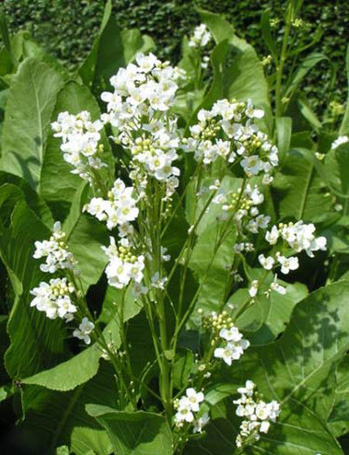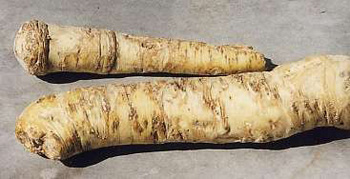Contents:
Common Names | Parts Usually Used | Plant(s) & Culture | Where Found | Medicinal Properties | Biochemical Information
Legends, Myths and Stories | Uses | Formulas or Dosages | Warning | Bibliography
Scientific Names

- Armoracia lapathifolia L.
- Cochlearia armoracia Lam.
- Cruciferae
- Crucifer family
Common Names
- Horseradish
Parts Usually Used
Root
Back to Top

Description of Plant(s) and Culture
A perennial hairless plant; the very long, white, cylindrical or tapering root produces a 2-3 foot high stem in the second year. The large basal leaves are lanceolate with scalloped edges; the stem leaves are much smaller, sessile, lanceolate, and serrate to entire. A panicle of numerous white flowers appears during June and July. The fruits are round pods on long, upright stalks. The root has a biting-hot taste.
Back to Top
Where Found
Native to southeastern Europe and western Asia, and occasionally found wild but usually cultivated in other parts of the world.
Back to Top
Medicinal Properties
Diuretic, rubefacient, stomachic, stimulant, laxative
Back to Top
Biochemical Information
Essential oil with mustard oil, enzymes, glycosides, vitamin B, asparagin, thiocyanogen compounds
Back to Top
Legends, Myths and Stories
Horseradish and chicory are used at the Passover seder as bitter herbs, commemorating the misery of the Jewish slaves in Egypt.
This plant was introduced as a condiment in England in the 1600s, but according to an herbalist of the era, “only for country people and strong laboring men”.
Back to Top
Uses
The diuretic properties of fresh horseradish make it useful for gouty and rheumatic problems and also bladder infections. For the latter, take 3-4 tbsp. a day of grated horseradish with wine vinegar and some grape sugar, (dextrose). For colitis and intestinal problems due to putrefaction, 15-20 drops of juice taken 3 times a day between meals will help. For catarrhal lung problems, coughs, and asthma, take horseradish combined with honey and raw sugar. Used to treat disorders of the renal system, kidney stones, and dropsy. Externally, it is used as an irritant to stimulate blood flow; fresh horseradish can be made into a poultice, add a little cornstarch to the grated herb, for rheumatism, poultice for bronchitis, and into a bath additive for chilblains. Stimulates the appetite and acts as a tonic to the whole system. Has been useful in regenerating blood vessels, especially the arteries, and reduce the blood pressure.
The freshly grated root, combined with vinegar or lemon juice, is used as a condiment with meat. It is also an ingredient in many sauces. Fresh root will not keep more than 3 months.
Very pungent flavor, the roots are high in vitamin C.
Plant at corners of a potato patch to deter potato bug.
Back to Top
Formulas or Dosages
Only undried (fresh or bottled) horseradish is effective. The root can be preserved fresh for months in a refrigerator or packed in damp sand and kept in a cool place.
Vinegar: cover finely grated horseradish with vinegar and let stand for 10 days. Take 1 tsp., 2-3 times a day, well diluted with water. This can also be applied externally.
Poultice: spread fresh, grated root on a linen cloth. Lay on the affected area, with cloth against the skin, until a burning sensation is felt.
Syrup: steep 1 tsp. root in 1/2 cup boiling water in a covered pot for 2 hours. Strain and add sugar until a syrupy consistency is reached.
Horseradish taken in any form can be made more palatable with sugar or honey.
Back to Top
Warning
Do not take large quantities of horseradish at one time. Stop taking it if diarrhea, vomiting, or night sweating occurs. The fiery taste of horseradish would deter any large doses normally. It is best to use the fresh herb if it is available.
Back to Top
Bibliography
![]() The Herb Book
The Herb Book, by John Lust, Bantam Books, 666 Fifth Avenue, New York, NY. copyright 1974.
![]() Eastern/Central Medicinal Plants
Eastern/Central Medicinal Plants, by Steven Foster and James A. Duke., Houghton Mifflin Company, 215 Park Avenue South, New York, NY 10000
![]() The Nature Doctor: A Manual of Traditional and Complementary Medicine
The Nature Doctor: A Manual of Traditional and Complementary Medicine, by Dr. H.C.A. Vogel; Keats Publishing, Inc., 27 Pine Street (Box 876) New Canaan, CT. 06840-0876. Copyright Verlag A. Vogel, Teufen (AR) Switzerland 1952, 1991
Herbal Gardening, compiled by The Robison York State Herb Garden, Cornell Plantations, Matthaei Botanical Gardens of the University of Michigan, University of California Botanical Garden, Berkeley., Pantheon Books, Knopf Publishing Group, New York, 1994, first edition
 The Magic of Herbs
The Magic of Herbs, by David Conway, published by Jonathan Cape, Thirty Bedford Square, London, England. (Out of print)
![]() Indian Herbalogy of North America
Indian Herbalogy of North America, by Alma R. Hutchens, Shambala Publications, Inc., Horticultural Hall, 300 Massachusetts Avenue, Boston, Massachusetts 02115, 1973
 Earl Mindell’s Herb Bible
Earl Mindell’s Herb Bible, by Earl Mindell, R.Ph., Ph.D., Simon & Schuster/Fireside, Rockefeller Center 1230 Avenue of the Americas, New York, New York 10020
![]() Planetary Herbology
Planetary Herbology, by Michael Tierra, C.A., N.D., O.M.D., Lotus Press, PO Box 325, Twin Lakes. WI 53181., Copyright 1988, published 1992
![]() American Folk Medicine
American Folk Medicine, by Clarence Meyer, Meyerbooks, publisher, PO Box 427, Glenwood, Illinois 60425, 1973
![]() Webster’s New World Dictionary
Webster’s New World Dictionary, Third College Edition, Victoria Neufeldt, Editor in Chief, New World Dictionaries: A Division of Simon & Schuster, Inc., 15 Columbus Circle, New York, NY 10023
 An Instant Guide to Medicinal Plants
An Instant Guide to Medicinal Plants, by Pamela Forey and Ruth Lindsay, Crescent Books (January 27, 1992).
![]() The Yoga of Herbs: An Ayurvedic Guide to Herbal Medicine
The Yoga of Herbs: An Ayurvedic Guide to Herbal Medicine, by Dr. David Frawley & Dr. Vasant Lad, Lotus Press, Twin Lakes, Wisconsin, Second edition, 1988.
 The Rodale Herb Book: How to Use, Grow, and Buy Nature’s Miracle Plants (An Organic gardening and farming book)
The Rodale Herb Book: How to Use, Grow, and Buy Nature’s Miracle Plants (An Organic gardening and farming book), edited by William H. Hylton, Rodale Press, Inc. Emmaus, PA, 18049., 1974
![]() Country Home Book of Herbs
Country Home Book of Herbs, Meredith Books, Editorial Dept. RW240, 1716 Locust Street, Des Moines, IA 50309-3023, copyright 1994
